Guitars, basses, effects and amps |
| Electric guitars |
| Hagstrom Futura II |
Bought in 1964/65 |
1964 |
|
|
| 1965 Fender Telecaster |
Neck date of November 1965 (s/n L807280). This guitar used to be owned by Marc Bolan. Mike added an extra pickup - made by Bill Lawrence - to it, with the help of his dad in their garden shed. Mike later took all the finish off the guitar, leaving it as bare wood. The guitar was offered through Chandler for £20,000 but wasn’t sold. It was then to be auctioned off by Bonhams on June 20, 2007 (Lot 391) with an estimate of £25,000 - 35,000. Next attempt was on January 15, 2008 (Lot 361, estimate £10,000 - 15,000). The last attempt was made on December 16, 2009 (Lot 277, estimate £8,000 - 12,000). All attempts failed due to low bids and the guitar was withdrawn. It was sold in January 2010 by charity SANE to English guitarist Keith Smart. Video
                  
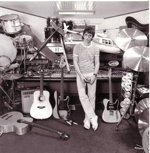 |
|
2007 |
Tubular BellsOmmadawn (Mike told H & SR magazine in 1991 that this was "the main guitar on Ommadawn". He slightly contradicts himself a few sentences later, in saying that "the guitar sound on Ommadawn" was that of a Les Paul Junior through a Fender amp. Pictures of Mike at the time, as well as the 'All You Need is Love' documentary, suggest that Mike's go-to guitar was the SG/Les Paul Junior, not the Telecaster.)Five Miles Out (Shown in the photo of Mike's studio on inside of the gatefold of the LP)AmarokTubular Bells 2003 |
| 1966 Gibson SG Junior |
This SG was bought with some of the first royalties from Tubular Bells. Mike used it on Hergest Ridge, before it was stolen from The Beacon.
      
 |
|
|
Hergest RidgeThe Orchestral Tubular Bells [?] |
| Fender Lap Steel |
Used on Ommadawn for the sliding sounds during On Horseback. |
|
|
Ommadawn |
| 1962 Gibson Les Paul/SG Junior |
s/n 77138. This is one of the early models of SG which still had the Les Paul logo on the headstock. Mike bought this to replace the SG that was stolen from The Beacon. It became one of his most used guitars, being used extensively on albums and concerts throughout the 70s and 80s. He sold it through Chandler Guitars in February 2006. It was bought by a Swiss fan.
            
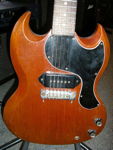 |
|
2006/02 |
Ommadawn [?] (The pictures in the Boxed booklet, taken after Ommadawn was recorded, suggest that Mike had only one SG-Les Paul at the time, with a retrofitted nickel-plated adjustable bridge. As the 62 SG still had a nickel-plated adjustable bridge when Mike sold it, that would point to the 63 SG, with a brass bridge, being a later acquisition and the 62 being the guitar used on Ommadawn.)QE2 (Mike seems to have been using this guitar a lot at the time, and certainly its sound seems recognisable on the album. His other SG seems to have been bought later on, pointing to it being this guitar on the album.)Crises |
| 1957 Gibson Les Paul TV model |
s/n 7 2031. This guitar was modified with a 2 octave fretboard. It was bought by a Scottish fan.
    
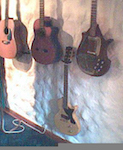 |
|
2006/02 |
Ommadawn [?]Incantations (Mike told Guitar Player that this was his main instrument and that he used it the most.)Five Miles Out (Shown in the photo of Mike's studio on inside of the gatefold of the LP)Discovery (Strung up with 8 gauge strings, so Mike could reach a high G if necessary.)Amarok |
| Gibson L6-S Deluxe |
Mike had this guitar modified by Tony Zemaitis sometime between 1979 and 1980. He added an engraved metal scratchplate and headstock plate.
 
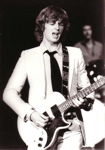 |
|
|
Incantations (This appears to have been Mike's favourite of the two L6-Ss, and likely the one used on Incantations, with the wine red L6-S Custom being acquired as a spare for touring.)ExposedPlatinum |
| 1962 Gibson EBSF-1250 Cherry Red Electric Doubleneck, Bass and 6 String, Serial # 90448 |
Sold on Guitar Auctions on 8th March 2023 for 12.500 GBP.
Purchased by the vendor in October 1994 from a friend of Mike Oldfield who was storing it in his barn. It was offered by Mike's personal assistant, Jeremy Parker, who told the vendor where to collect it.
The guitar was used in thePlatinum and QE2 period, also appearing on the Essential Knebworth Concert and Wonderful Land videos.
Only 22 were built.
    
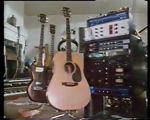 |
1979 |
1994/10 |
|
| Gibson L6-S Custom |
Wine red. This guitar was sold in an auction at Abbey Road. |
|
|
Exposed |
| 1959 Fender Stratocaster, sunburst |
This was the first of the Strats that Mike bought. The scratchplate of this guitar was modified, probably in the 1990s, to make space for a Roland GK-2 synth pickup.
  
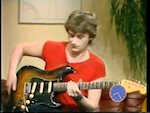 |
|
|
CrisesDiscoveryTubular Bells II (Used for playing guitar synth parts) |
| Roland G-808 |
Guitar controller for Roland guitar synthesis system.

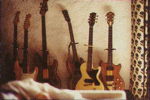 |
|
|
CrisesDiscovery |
| 1963 Gibson Les Paul/SG Junior |
This Les Paul/SG was heavily modified by Richard Barrie and Chandler Guitars to include a pickup and circuitry for a Roland guitar synthesiser system. This was used to create some of the unique distorted guitar/synth blend sounds which featured on his 80s recordings - among them Tricks of the Light and Shine, the video for which features this guitar. Sold through Chandler to an English fan.
     
 |
|
2006/02 |
Discovery (According to the 1984 Guitarist magazine interview, this was used for "quite a lot of the lead breaks". Mike had fitted the synth pickup to it by this stage, and he used it to bring a layered synth and distorted guitar sound to his solos.) |
| 1963 Fender Stratocaster, fiesta red |
s/n L08044. Mike once said in an interview (The Raft) that this was his favourite guitar and that he'd never sell it. However, he finally decided to part company with it in December 2007 and sold it through Chandler guitars, fetching £30,000.
         
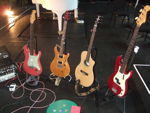 |
|
2007/12 |
DiscoveryAmarokTubular Bells IIThe Songs of Distant EarthVoyagerTubular Bells IIITubular Bells 2003Light + Shade |
| Danelectro/Coral Sitar |
An electric guitar with a special bridge to produce a buzzy sitar-like sound.

 |
|
|
Islands (Used on the intro to 'Flying Start', as well as in parts of The Wind Chimes.)AmarokGuitars |
| 1989 PRS Signature, Vintage Yellow |
A particularly high grade, limited edition, version of the Custom 24. In Vintage Yellow.
           
 |
1989 |
|
Earth MovingAmarokTubular Bells IIThe Songs of Distant EarthVoyagerTubular Bells IIITubular Bells 2003 (Used through GP-8)Light + ShadeReturn To Ommadawn |
| Höfner Shorty Super "Tubular Bells Guitar" |
Unusual presentation guitar, 1970s, the miniature, natural-finish body with pickup marked Shadow, built-in battery-powered speaker with on/off switch, one volume and one tone control, black scratchplate with Mike Oldfield in white, backplate engraved "To Mike from all your friends from Virgin Germany", neck with dot markers, headstock with Schaller machineheads and 'Tubular Bells' logo, with strap
    
 |
|
|
Amarok |
| Vox 'electric mandolin' |
This is actually a mini 12 string electric guitar. Borrowed from Tom Newman, it used to belong to Cat Stevens. |
|
|
Amarok |
| Gibson ES335 |
Mike bought this in LA. He later replaced it with a PRS Hollowbody, which he said he preferred. It later appeared in a tweet by Caroline Monk and may now be owned by her.
      
 |
|
|
Tubular Bells II (A number of pictures of Mike in his Los Angeles studio show Mike with this guitar, suggesting he may have been using it to record Tubular Bells II.) |
| PRS Custom 24, Dark Cherry Sunburst – with Roland GK-2AH pickup |
Modified by Chandler Guitars and Richard Barrie to include a built-in Roland synth pickup. Sold by Chandler Guitars to an English fan in February 2006.
     
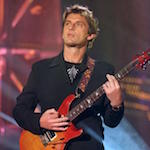 |
|
2006/02 |
VoyagerTubular Bells IIITubular Bells 2003 (Used with VG-8) |
| 1988 or 1989 PRS McCarty Hollowbody II, McCarty Sunburst |
    
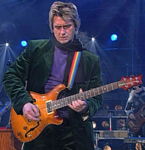 |
|
2006/02 |
Tubular Bells 2003 (Played through Twin Reverb for distorted guitars) |
| Squier Standard Telecaster, black mirror plate |
s/n IC041009490 sold for £395 via Chandler Guitars in Dec 07
     
 |
2004 |
2007/12 |
|
| Fender Mark Knopfler signature Stratocaster |
Used in the Bahamas era. |
|
|
Tubular BeatsMan on the RocksReturn To Ommadawn |
| 2013 (?) Fender Classic Player Telecaster Deluxe with Tremolo – 2-Colour Sunburst |
Used by Mike in the Bahamas era.

 |
|
|
Tubular Beats [?]Man on the RocksReturn To Ommadawn |
| 2010 Squier Vintage Modified SH Telecaster – Metallic Red |
Metallic Red Telecaster with maple fretboard. It has Duncan Designed pickups - a humbucker in the neck position and a stacked humbucker in the bridge position. It also features a reversed control plate.

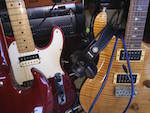 |
|
|
Man on the Rocks [?] |
| White Telecaster with maple fretboard |
Presumably by Fender |
|
|
Return To Ommadawn (Shown in one of Mike's collage photos.) |
| 2015 Gibson SG Standard P-90 T – Heritage Cherry |

 |
2015 |
|
Return To Ommadawn |
| UBO II |
This has been on the instruments list for a long time, but it's not clear what it is - if anyone has more information, please get in touch! |
|
|
|
| Fender Stratocaster, dark blue |
|
|
|
|
| Fender American Elite Telecaster, aged cherry burst |
With maple fretboard. Bought new in 2017. |
|
|
|
| Fender XII |
12 string electric guitar with split pickups. Sunburst finish. Seen in the background in the Essential Mike Oldfield video. |
|
|
|
| 1968 Gibson Les Paul Custom |
This can be seen in some of the pictures in the Boxed booklet. Nobody's quite sure which recordings it was used on. |
|
|
|
| 1959 Gibson Les Paul Special, ivory |
It's disputed whether Mike ever actually owned this guitar or just borrowed it for a photo shoot. He appears with it on the front of the East German Amiga Quartett EP.
      
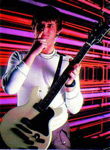 |
|
|
|
| Gordon Smith |
Gordon Smith Guitars is a British guitar company, which produces mainly Gibson-influenced electric guitars. This is, unfortunately, another item which has found its way onto our list without any further information - if you can help, do get in touch! |
|
|
|
| 2011 or 2012 PRS Studio second version, Black Gold |
Used during the 2012 Olympics.
   
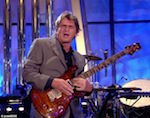 |
|
|
|
| Veillette-Citron |
|
|
|
|
| 1963 Fender Stratocaster, white (resprayed) |
s/n L 13996. Neck date 2 JUL 63 B. The preowner bought it some years ago from Mike Oldfield in a studio in Munich. Mike has oversprayed the original lake placid blue finish with a white lacquer. After purchase the preowner removed the white lacquer very carefully in the MUSIC SHOP München. Mike replaced the original tuners , the tremolo block, a 5-way switch and the pots by new parts. (This was sold on eBay in 2007 for 15550 euros.)
            
 |
|
2007/01 |
|
| Fender 60th Anniversary Strat |
Mike played this guitar in many of his Night of the Proms appearances in 2006
       
 |
|
2007/12 |
|
| Nylon-string guitars |
| 1974 Jose Ramirez 1A Traditional |
s/n 7987
          
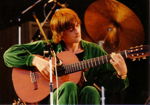 |
1974 |
2007/12 |
Hergest RidgeThe Orchestral Tubular Bells [?] (Mike bought this at some point during 1974, so the chances are high that if he didn't use the mystery Japanese classical guitar, he used this for his classical guitar part in Part Two.)OmmadawnAmarokVoyagerTubular Bells 2003Light + Shade |
| 1975 Jose Ramirez 1A Flamenco |
s/n 8666. Sold through Chandler to a French Fan and later resold to a German fan.
            
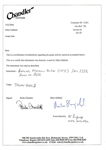 |
1975 |
2007/12 |
AmarokTubular Bells IITubular Bells 2003 |
| 1999 Jose Ramirez 1A C-530 Alto |
s/n Z 8 - 097. Mini classical guitar, called a 'couch guitar' by Mike in the Raft interview. Sold to a fan via Chandlers Guitar in 2008, and resold to RUDI TFAO Guitars in Holland in 2009.
                            
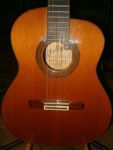 |
1999 |
2008/01 |
|
| 2006 Paco de Lucia flamenco guitar |
|
2006 |
|
|
| 2006 Vicente Carillo Premiera Especial |
Classical guitar.

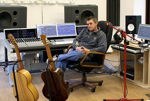 |
2006 |
|
Music of the Spheres [?]Tubular Beats [?] |
| Lowden S25J |
Nylon string electro-acoustic, used for stage work.

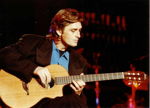 |
|
|
|
| Jose Ramirez 2CWE |
Electro-classical, sold to an English fan through Chandler Guitars in February 2006.
   
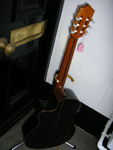 |
|
2006/02 |
|
| Steel-string acoustic guitars |
| Martin D-35 (hired) |
Hired from Maurice Placquet for recording Tubular Bells. Mike later complained that the guitar had an almost impossibly high action, saying that him struggling to play it was the reason you can hear him breathing heavily during some of the acoustic guitar sections! |
|
|
Tubular Bells |
| Dick Knight Jumbo acoustic guitar |
Bought by Mike from a shop on Denmark Street in the late 1960s. Maple back and sides, spruce top. Mike strung it with silk and steel strings for a super-light action. Used on the Sallyangie sessions, and played in the Tubular Bells Second House performance. Whether it was used on Tubular Bells at all is unknown. Sold by Terry in 1974.
 
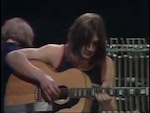 |
|
1974 |
Tubular Bells [?] (Mike had owned this for a number of years, and didn't sell it until sometime around 1974. Considering he'd found the hired Martin difficult to play, and the Knight was reportedly extremely comfortable to play, it would seem strange that he carried on with the unplayable Martin. There's no actual evidence that he used it on the album, though.) |
| 1975 Zemaitis acoustic guitar |
Custom-built for Mike. Can be seen at Hard Rock Café Guangzhou: "1975 custom Zemaitis 6-string acoustic guitar with mother of pearl acorns and squirrels on neck and sound hole, owned by 'Tubular Bells' composer Mike Oldfield." |
1975 |
|
Ommadawn |
| Martin D-35 |
The exact year the guitar was built is unknown, but in the All You Need is Love documentary, it appears to be quite new. It's possible Mike bought it in 1974 after Terry sold his Dick Knight acoustic for him.

 |
|
1980 |
Ommadawn |
| 1973 Martin D-28-12 |
Serial number 335787. Sold to a German fan through Chandler Guitars in December 2007.
     
 |
|
2007/12 |
OmmadawnDiscoveryAmarokTubular Bells III [?] (Most likely the 12 string acoustic guitar used for the rhythm parts on Man in the Rain.) |
| Manson acoustic |
Worth £439, swapped for a Martin D-35. From c.1980.
 
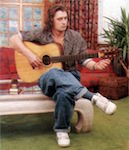 |
1980 |
|
Five Miles OutCrises |
| 1984 Ovation 1687-2 Adamas – Reverse Red Burst |
Electroacoustic guitar with carbon fibre top.
            
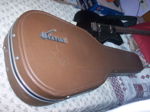 |
|
2006/02 |
CrisesDiscovery (In 1984, Mike told Guitarist magazine that this guitar was used for many of the acoustic rhythm parts, often recorded in a small room or corridor. He also used it for the solo on To France.)Tubular Bells 2003 |
| 1960 Martin 00-21NY |
Sold via Chandler Guitars to a Scottish fan in December 2007.
       
 |
|
2007/12 |
Amarok [?] (This is likely the guitar used for the opening Fast Riff.)Voyager [?] (Likely used for some of the album's acoustic melodies, as Mike seems to have favoured its focused sound for this kind of task.)Tubular Bells 2003 |
| Lowden Artist LSE II Stage Edition |
s/n 3310
           
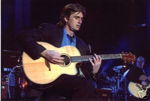 |
1992 |
2006/02 |
|
| 1985 Taylor K-22 |
Koa-bodied acoustic guitar, sold via Chandler Guitars to a fan in February 2006.
    
 |
|
2006/02 |
Tubular Bells 2003 |
| Line 6 Variax 700 acoustic |
Played on the Night of the Proms tour.
   
 |
2006 |
|
|
| 2013 Andy Manson Heron |
Acoustic guitar

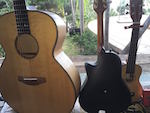 |
2013/12 |
|
Return To Ommadawn |
| Aria Acoustic |
|
|
|
|
| Eko acoustic |
Mike's first guitar, bought for him by his father in 1963/64 |
|
|
|
| 2013 (?) Gibson J-45 True Vintage – Vintage Sunburst |
A reproduction of the 1942 Gibson J-45. Used by Mike in the Bahamas era.
       
 |
|
|
|
| Ovation acoustic |
  
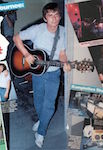 |
|
|
|
| Ovation 12 String |
|
|
|
|
| Ovation cutaway |
|
|
|
|
| Washburn Mirage Deluxe |
Hand built semi-solid electro acoustic guitar. Serial number 833908, presumably from 1983. Used on the 1984 Discovery tour. Given to Jeremy Parker, then sold to Alexander Müller.
   
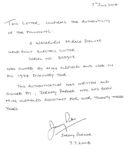 |
|
|
|
| Bass guitars |
| Fender Telecaster Bass |
According to Phil Newell, Mike borrowed this bass from him for recording Tubular Bells. |
|
|
Tubular Bells |
| 1960 Fender Precision Bass, blonde |
s/n 48986. Mike bought this shortly after recording Tubular Bells. He played it on the BBC Second House performance in 1974. The frets were later removed from it. Sold via Chandler Guitars in February 2006.
    
 |
|
2006/02 |
Hergest RidgeOmmadawnIncantationsQE2 (Mike used this bass on the tour for the album, and it seems to have been a favourite of his, so is likely the source of all the Precision Bass parts on the album.)Five Miles Out (Shown in the photo of Mike's studio on inside of the gatefold of the LP) |
| Gibson EB3 |
SG-shaped electric bass. |
|
|
Ommadawn |
| 1975 Zemaitis acoustic bass guitar |
Sold via Chandler Guitars in February 2008
    
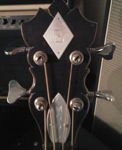 |
1975 |
2008/02 |
OmmadawnIncantationsFive Miles Out (Shown in the photo of Mike's studio on inside of the gatefold of the LP) |
| 1962 Gibson EBSF-1250 Cherry Red Electric Doubleneck, Bass and 6 String, Serial # 90448 |
Sold on Guitar Auctions on 8th March 2023 for 12.500 GBP.
Purchased by the vendor in October 1994 from a friend of Mike Oldfield who was storing it in his barn. It was offered by Mike's personal assistant, Jeremy Parker, who told the vendor where to collect it.
The guitar was used in thePlatinum and QE2 period, also appearing on the Essential Knebworth Concert and Wonderful Land videos.
Only 22 were built.
    
 |
1979 |
1994/10 |
|
| Aria Pro II SB-1000 |
Sen (Japanese Ash) body
 
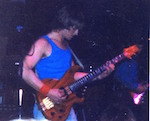 |
1982 |
|
|
| 1983 Roland G-88 Bass Guitar Controller, Serial # A814722 |
Bass guitar designed for controlling the GR-33B bass synthesiser. It can also be used as a conventional bass, which Mike seems to have done.
Sold on Guitar Auctions with a Roland GR-33B bass guitar synthesizer pedal unit, Serial # 050634 (missing multi-pin cable).
Purchased by the vendor in October 1994 haveing been offered the bass by Jeremy Parker, Mike's then personal assistant. The vendor was offered the guitar as he was a known fan of Mike Oldfield.
The instrument can be seen in the videos for 'Shadow On The Wall', 'Pictures In The Dark' and 'Islands'.
          
 |
1983 |
1994/10 |
Crises (Mike appears with it in the Shadow on the Wall video, so it's quite likely he used it on the album.)DiscoveryIslands |
| 1989 PRS Bass 5, Whale Blue, s/n 990631 |
Around 1991/1992, when Mike Oldfield recorded Tubular Bells II, he used a PRS 5 String which he sold back to the Chandler Guitars after he did the album. Rumour from Doiug Chandler has it that Mike Oldfield never even used it on the record. The bass was in mint condition when it was later sold in March 2003.

 |
1989 |
|
|
| PRS Bass 4, Vintage Yellow |
  
 |
|
|
AmarokTubular Bells II (Seen in the 'Making of TB2' video clips, so presumably used on the album as well.) |
| 1991 Wal Custom bass |
s/n W3557. Sold to a German fan via Chandler Guitars in February 2006.
    
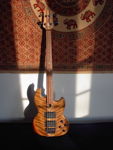 |
1991/04 |
2006/02 |
Tubular Bells IITubular Bells III [?]GuitarsTubular Bells 2003 |
| Mid 60s Fender Precision Bass, fiesta red |
 
 |
|
|
Light + Shade |
| 2006 Fender American Standard Precision Bass |
|
2006 |
|
|
| 2007 Fender Roscoe Beck Bass® IV – 3-Colour Sunburst |
Used in the Bahamas era
  
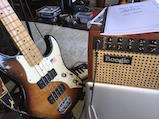 |
|
|
Man on the RocksReturn To Ommadawn |
| Fender Kingman |
Acoustic bass |
2016 |
|
Return To Ommadawn |
| Shaftsbury Ned Callan Cody bass |
1973 - 74
  
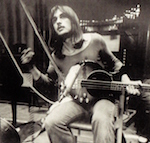 |
|
|
|
| Wal five string bass |
|
|
|
|
| Guitar effects |
| Glorfindel Box |
A type of custom effects unit, which Mike probably got from David Bedford. Exactly what it did is slightly shrouded in mystery, though it's known that Mike used it to make the 'bagpipe' sound on Tubular Bells. Tom Newman, writing on Facebook, said "It was made of plywood and had about five or six 250mm faders and about four knobs, about ten inches by eight inches with a sloping top like a mixer, and a hole with a 9volt battery that fell out if you picked it up". |
|
|
Tubular Bells |
| MXR Pitch Transposer |
Blue rack unit that can often be spotted in Mike's early 80s guitar racks - e.g. on top of the rack in the Essential Mike Oldfield interview footage. Can be used for anything from subtle chorus-like detuning to extreme pitch shifts. |
|
|
QE2 (Presumably, as it was shown in his studio in the 1980 Essential Mike Oldfield interview, he was using it on the album.)Five Miles Out (On top of the mixing desk in the gatefold studio picture, so presumably used on the album.) |
| Roland GP-8 |
Guitar effects processor used for Mike's trademark 90s distorted guitar sound. Sold via ebay in December 2007. |
|
2007/12 |
AmarokTubular Bells IIThe Songs of Distant EarthTubular Bells 2003 |
| Roland VG-8 |
Guitar modelling processor, able to model the sounds of different guitars and other instruments. It uses a GK-series synth pickup to provide the unit with an uncoloured signal, but the VG-8 is not technically a synthesiser as it purely remodels the signal from the pickup. One was sold via ebay in December 2007, but he lists one as having been used on Tubular Bells 2003, so presumably he had a spare!
 
 |
|
2007/12 |
VoyagerTubular Bells IIIGuitarsThe Millennium BellTres LunasTubular Bells 2003 |
| Digidesign/Avid Eleven Rack |
Guitar amp simulator. Shown in multiple pictures of Mike's studio around 2016. |
|
|
|
| Boss GT-5 |
Guitar multieffects unit. |
|
|
|
| Ernie Ball volume pedal |
Spotted in Mike's 1984 touring rig. |
|
|
|
| Mesa Boogie Triaxis |
Rackmounted valve guitar preamp, spotted in Mike's rack during the TSODE era. |
|
|
|
| MXR Graphic Equaliser |
This, according to Richard Barrie, was the EQ used in front of Mike's Mesa Boogie amplifiers in the 80s, boosting the mids to get his characteristic distorted lead sound. |
|
|
|
| Roland GP-100 |
Guitar preamp. |
|
|
|
| Roland GS-6 |
Guitar effects processor. |
|
|
|
| Boss FV-200 |
Sold via eBay in December 2007.
 
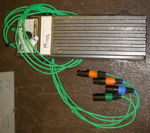 |
|
2007/12 |
|
| Boss GT-6 |
Sold via eBay in December 2007.

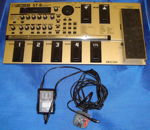 |
|
2007/12 |
|
| Roland EV-5 |
Expression pedal. Sold via eBay in December 2007.

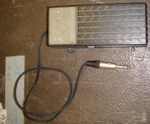 |
|
2007/12 |
|
| Roland FC-100 |
Foot controller, sold via eBay in December 2007.

 |
|
2007/12 |
|
| Roland US-20 |
For sharing and switching the output of a GK-2AH pickup between two devices. Sold via eBay in December 2007.

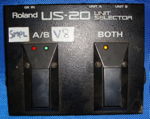 |
|
2007/12 |
|
| Amps |
| Fender Twin Reverb |
This was hired from Maurice Placquet for Tubular Bells. One with JBL speakers had been requested, but the hire receipt has the note "Where were the JBLs." scribbled on it, suggesting they were delivered one with different speakers. |
|
|
Tubular Bells (A lot of the electric guitar sounds on the album seem to have been recorded by plugging the guitar directly into the mixer, so it's diffcult to tell exactly where on the album the amp might have been used.) |
| Fender Twin Reverb |
|
|
|
OmmadawnIncantationsExposedDiscoveryTubular Bells 2003Return To Ommadawn |
| Vox Escort |
Battery powered guitar amplifier, used as part of the signal chain for Mike's mid 70s distorted guitar sound. Can be seen in the William Tell Overture video. |
|
|
Incantations |
| Fender Princeton |
|
|
|
Exposed |
| Mesa/Boogie |
To get his distorted guitar sound from this amp, Mike overloaded the input by running the guitar through a preamp first. The sound then went into the mixer, where the input was overloaded, then through the Vocal Stresser and a parametric EQ, then a gate and a limiter. (Guitarist, 1984) |
|
|
ExposedFive Miles Out (Shown in the photo of Mike's studio on inside of the gatefold of the LP)Discovery (Used for distorted guitars.)Tubular Bells 2003 |
| 2015 MESA/Boogie® MARK FIVE: 35™ |

 |
2015 |
|
Return To Ommadawn |
| Trace Elliot GP11 |
Bass head with cabinets.

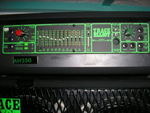 |
|
2008/09 |
|
Miscellaneous stringed instruments |
| CF Martin Style B Mandolin |
Used throughout the 70s and into the 80s, when he acquired the Mike Vanden F4-style mandolin. It appears in the videos for Portsmouth and William Tell Overture. |
|
|
Tubular Bells [?] (It's not clear when Mike acquired the mandolin, but no mandolin was hired for Tubular Bells, so it's possible he used this one.)Hergest RidgeOmmadawn |
| Greek Bouzouki |
|
|
|
Ommadawn |
| Harp |
|
1975 |
|
OmmadawnIncantations |
| Gibson RB-250 Mastertone Banjo |
Mike appeared with this banjo at the Tubular Bells II premiere concert in Edinburgh. Its appearance is consistent with a post-1960s RB-250, so our current best guess is that it's the same banjo which Mike used on every album from Ommadawn onwards.

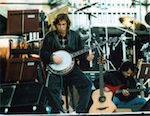 |
|
|
OmmadawnCrisesAmarokTubular Bells II |
| Bowed Psaltery |
|
|
|
Amarok |
| Ukulele |
|
|
|
Amarok |
| Violin |
|
|
|
Amarok |
| John Le Voi Bouzouki |
Flat-backed bouzouki, sold via Chandler Guitars in February 2006. |
|
2006/02 |
Amarok |
| Mike Vanden 'MJV' F4 style Mandolin |
Originally bought from John Alvey Turner's music shop. Sold via Chandler Guitars in December 2007.
       
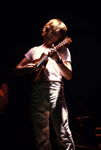 |
|
2007/12 |
AmarokVoyagerTubular Bells 2003 |
| Kala KA-SSLNG ukulele |
Long-necked ukulele consisting of a soprano ukulele body with a concert ukulele scale length. Solid spruce top, laminated mahogany back and sides. |
|
|
Return To Ommadawn |
| Banjo |
|
|
|
Return To Ommadawn |
| Celtic Harp |
Compact (29 string?) folk harp, decorated with Celtic patterns. Carved rosewood body, likely made in Pakistan. |
|
|
Return To Ommadawn |
| Ovation MCS148 Mandolin |
|
2016 |
|
Return To Ommadawn |
| Washburn M1S Mandolin |
|
2016 |
|
Return To Ommadawn |
| Electric Mandolin |
Reputedly a prototype made for Mike Oldfield, now owned by Mick Irving, lead guitarist of Light Alloy. Purchased from Macari's Music, Charing Cross Road, London, in the mid 70s.

 |
|
|
|
| Deering Intermediate 5 string banjo |
Sold via Chandler Guitars in February 2006. |
|
|
|
| Bernard Ellis Dulcimer |
Bernard Ellis was a musical instrument maker in Dilwyn, near Kington, who specialised in instruments for early music. Mike ordered this Appalachian Dulcimer with mother of pearl inlays from Bernard after being introduced to him by Les Penning. The instrument can be seen in one of the photos of Mike in Boxed. |
|
|
|
Keyboard instruments |
| Pianos |
| Grand Piano |
The grand piano was owned by The Manor and was built by Steinway & Sons. |
|
|
Tubular Bells |
| Steinway Model B |
Black Steinway baby grand, used at The Beacon. |
|
|
Ommadawn |
| Bösendorfer grand piano |
This piano is shown in pictures of Mike in his Througham studio, so it's likely he used it on the recordings he made there. |
|
|
Incantations |
| Fender Rhodes electric piano |
|
|
|
Discovery |
| Steinway Model B |
Studio grand piano. No 137655. When this piano was auctioned, it was listed as being a 6'11" piano, c.1910, with a rosewood case. |
1987 |
2007/12 |
AmarokTubular Bells 2003 |
| Steinway Model C |
Grand piano. The notes for Tubular Bells 2003 list an 8 foot Steinway grand. The model C is 7'5" 1/2", the Model D is 8'11 3/4" - it could be either of those! The frame was from the 1920s, but the piano was rebuilt. |
|
|
Voyager [?]Tubular Bells 2003Light + Shade (Listed as a 1928 Steinway) |
| Grandma's pub piano |
Sampled (?) piano used on Return To Ommadawn. |
2016 |
|
Return To Ommadawn |
| Blüthner baby grand |
Kept in Mike's living room in the early 90s. |
|
|
|
| Wurlitzer electric piano |
|
|
|
|
| Organs |
| Farfisa Professional Organ |
Return To Ommadawn used a Farfisa sotware emulation.

 |
|
|
Tubular Bells (A Farfisa organ was hired from Maurice Placquet, but it broke down. It's not clear whether the only Farfisa on the album is the broken hired organ or whether another was borrowed (for example, the Farfisa Mike had borrowed for the demos).)Hergest RidgeOmmadawnIncantationsCrisesAmarok (Having sold his original Farfisa organ, Mike obtained another in preparation for Tubular Bells II. He found it in a school for the disabled, and swapped it for his Yamaha DX7.)Tubular Bells IITubular Bells 2003Return To Ommadawn |
| Hammond Organ |
As this doesn't appear to have been hired from Maurice Placquet (it at least doesn't appear on the 1972 hire receipt), it would seem that this was either owned by The Manor or belonged to one of the bands who were recording there at the time. The model isn't known, but it was quite possibly a B3, certainly with a Leslie speaker. It's used towards the end of Part Two. |
|
|
Tubular Bells |
| Lowrey Organ |
|
|
|
Tubular BellsHergest RidgeAmarokTubular Bells IITubular Bells 2003 |
| Gemini Organ |
|
|
|
Hergest Ridge |
| 1970 Hammond L.122 Organ |
Return To Ommadawn used an Hammond software simulation. |
|
|
AmarokHeaven's Open [?] (As it's not listed in the sleeve notes, it may equally have been Mickey Simmonds's own Hammond organ used on the album.)Tubular Bells IITubular Bells 2003Return To Ommadawn |
| Vox Continental Organ |
Return To Ommadawn used a Vox software emulation. |
1991 |
|
AmarokReturn To Ommadawn |
| Hammond Leslie 116 |
Rotary speaker used with the Hammond L.122 to give the classic swirling Hammond organ sound. |
|
|
|
| Lowrey Spinet Organ |
|
|
|
|
| Synthesisers |
| Solina string ensemble |
String synthesiser produced by the Dutch organ company Eminent and later rebadged by ARP. It owed much of its sound to its ensemble effect, created by running the sound through three LFO-modulated delay lines. |
|
|
OmmadawnIncantationsPlatinumQE2Five Miles OutCrisesReturn To Ommadawn (Mike used a software emulation of a Solina rather than the real thing on this album.) |
| ARP 2600 |
Semi-modular analogue monophonic synthesiser. |
1975 |
|
OmmadawnIncantations |
| Roland SH-2000 |
Monophonic analogue synthesiser. Mike often used the clarinet preset, recording it at half speed to create the recorder-like whistling sound which was a common feature of his albums and singles between 1978 and 1980. |
|
|
IncantationsPlatinum |
| Fairlight CMI |
Mike claims to have been one of the first CMI owners. |
1979 |
|
|
| Moog Polymoog |
Polyphonic analogue synthesiser. |
|
|
PlatinumQE2 |
| Sequential Circuits Prophet V |

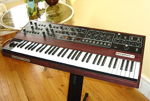 |
|
|
PlatinumQE2Five Miles OutCrisesDiscovery |
| Barth Musicoder |
Analogue vocoder built in the early 1980s by the R. Barth company in Hamburg, Germany. |
|
|
QE2 (In the 1981 Montreux concert video, Mike can be seen playing the vocoder parts on his Polymoog, with the MusiCoder in the rack case next to it. The closeness of the sound to that on the album suggests this is likely the same combination he used in the studio.)Five Miles Out (Seen in multiple pictures both in Mike's studio (it's on top of the Fairlight keyboard in the photo inside the LP gatefold) and on the Five Miles Out tour.) |
| Moog Taurus |
Bass pedals |
|
|
QE2 |
| Yamaha CS-80 |
Polyphonic analogue synthesiser, used on QE2 but probably owned by David Hentschel. |
|
|
QE2 |
| Fairlight CMI Series II |
Mike had two of these - the second was for live work. |
|
|
CrisesDiscoveryThe Killing Fields |
| Oberheim OB-Xa |
Sold together with DSX sequencer and 'Tubular Bells' flightcase to "Malcolm" for £540 in Spring 2000 at vemia.co.uk. OB-Xa later resold on ebay, March 2007. |
|
|
CrisesDiscovery (Can be seen perched on top of the Fairlight keyboard in Mike's 'synth corner' shown on the sleeve of some LPs of the album.)The Killing Fields |
| Roland GR-100 |
Guitar synthesis module controlled by Gibson SG with the Roland STK-1 GK kit. |
|
|
CrisesDiscovery |
| Roland G-808 |
Guitar controller for Roland guitar synthesis system.

 |
|
|
CrisesDiscovery |
| Roland VP-330 |
Analogue vocoder keyboard, often also used for its string sound. |
|
|
Crises (Used for its string sound - listed as 'Roland Strings')Discovery (Can clearly be seen in Mike's 'synth corner' shown on the sleeve of some LPs of the album.)Amarok (Mike told H & SR Magazine that he'd used this on the album for "some robot voices".) |
| 1983 Roland G-88 Bass Guitar Controller, Serial # A814722 |
Bass guitar designed for controlling the GR-33B bass synthesiser. It can also be used as a conventional bass, which Mike seems to have done.
Sold on Guitar Auctions with a Roland GR-33B bass guitar synthesizer pedal unit, Serial # 050634 (missing multi-pin cable).
Purchased by the vendor in October 1994 haveing been offered the bass by Jeremy Parker, Mike's then personal assistant. The vendor was offered the guitar as he was a known fan of Mike Oldfield.
The instrument can be seen in the videos for 'Shadow On The Wall', 'Pictures In The Dark' and 'Islands'.
          
 |
1983 |
1994/10 |
Crises (Mike appears with it in the Shadow on the Wall video, so it's quite likely he used it on the album.)DiscoveryIslands |
| Roland GR-33B |
Bass guitar synthesizer module controlled by a Roland G 88 bass guitar fitted with a synth pickup. |
1980 |
1984 |
DiscoveryIslands |
| Fairlight CMI Series III |
A further improvement of the CMI system, incorporating 16 bit sampling.

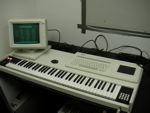 |
|
|
IslandsEarth MovingHeaven's Open |
| Kurzweil K250 |
|
1987 |
|
Islands |
| Roland MT-32 |
Table top Linear Algorhythmic Synthesis module. Low cost descendent of the D-50. Mike had two, for composing with while he was on holiday. |
|
|
IslandsEarth Moving |
| Roland D-50 |
Linear Algorhythmic synthesiser keyboard. |
|
|
IslandsEarth MovingAmarok (Mike told H & SR magazine that he'd used "a string sound and a bell-like sound" from the D50.)Heaven's OpenTubular Bells IIThe Songs of Distant Earth [?] |
| Roland D-110 |
Linear Algorhythmic synthesis module. |
|
|
IslandsEarth Moving |
| Yamaha DX-7 |
6 operator polyphonic digital FM synthesiser keyboard. Later given to a school for the disabled in exchange for a Farfisa Professional for Tubular Bells II. |
|
|
Islands [?] (Seems to feature quite heavily in The Wind Chimes.) |
| Korg M1 |
The biggest selling digital keyboard of all time, the Korg M1 was used by many artists after its release in 1988. |
|
|
Earth MovingHeaven's OpenTubular Bells IIThe Songs of Distant Earth (Mike used this as the master keyboard for his sequencing setup.) |
| Yamaha DX-100 |
Small synthesiser, used as a controller keyboard for Mike's 1980s portable sequencing setup. |
|
|
Earth Moving (In the 1989 Keyboards interview, Mike mentions using a small portable Roland keyboard while writing the album in Greece. It's listed in the article as a Roland DX 800, which never existed. It was probably this keyboard which was meant.) |
| E-Mu Proteus |
Digital sample playback sound module. |
|
|
Heaven's OpenTubular Bells IIThe Songs of Distant Earth |
| Roland D-550 |
Linear Algorhythmic Synthesis module. |
|
|
Heaven's OpenTubular Bells IIThe Songs of Distant Earth [?] |
| Ensoniq SD-1 |
|
|
|
Tubular Bells IIThe Songs of Distant Earth [?] |
| New England Digital Synclavier |

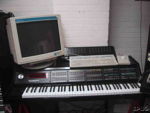 |
|
|
Tubular Bells II (Mentioned in Keyboards, October 1992.) |
| Roland JD-990 |
Rackmountable module version of the JD-800, with slightly enhanced synthesis engine, but missing its numerous sliders! |
|
|
The Songs of Distant Earth (Mike used two of these on the album (as seen in the 1994 VH1 interview).)Voyager [?]Tubular Bells III [?]The Millennium Bell [?]Tres Lunas [?]Tubular Bells 2003 (Used for pads.) |
| Korg Trinity |
|
|
|
Voyager [?]Tubular Bells IIIThe Millennium BellTubular Bells 2003 |
| Roland JV-1080 |
Digital synth module. |
|
|
Voyager [?]Tubular Bells IIIThe Millennium Bell |
| Roland XP-50 |
Digital synthesiser workstation. Bought by a fan in 2008 from Chandler Guitars. Can be seen in the Millenium Bells DVD, used for the beats for Art In Heaven among other things.
    
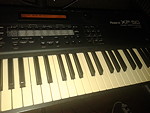 |
|
2008/04 |
Voyager [?]Tubular Bells III [?]The Millennium Bell [?]Tres Lunas [?]Tubular Bells 2003 (Used for pianos and percussion.)Light + Shade (This is a guess - he lists a Roland under 'keyboards' and this is a Roland keyboard which he owned at that time.) |
| Clavia Nord Lead |
|
|
|
Tubular Bells IIIThe Millennium BellTres LunasTubular Bells 2003 (Used for bass and 'sequency synths'.) |
| Roland GI-10 |
Guitar-MIDI interface, sold via eBay in December 2007.

 |
|
2007/12 |
GuitarsTres Lunas (Used to help create the 'saxophone guitar' parts) |
| Roland JV-2080 |
Digital synth module |
|
|
Tres LunasTubular Bells 2003 (Used for 'ethnic sounds' and bass.) |
| Yamaha Tyros 1 |
Sold via Chandler Guitars in September 2008.

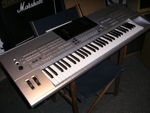 |
|
2008/09 |
Light + Shade [?] (This is, at a guess, the Yamaha referred to in the sleeve notes of the album.) |
| Clavioline |
Clavioline software emulation used on Return To Ommadawn. |
2016 |
|
Return To Ommadawn |
| EMS VCS3 |
Swapped for the ARP 2600 |
|
|
|
| E-Mu Vintage Keys |
|
|
|
|
| E-Mu Proteus II |
|
|
|
|
| E-Mu Proteus XR |
|
|
|
|
| Korg Sigma |
|
|
|
|
| Korg 05R/W |
A half rack module version of the X5, the 05R/W featured samples from many of its predecessors, including the M1, and added some which were new to the X series. |
|
|
|
| Minimoog Voyager |
Played by Mike at the 2012 London Olympics |
|
|
|
| Roland MKS-80 'Super Jupiter' + MPG-80 editor |
MIDI-controlled analogue sound module.

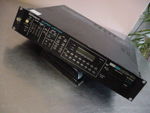 |
|
|
|
| Roland A-80 |
Controller keyboard.
     
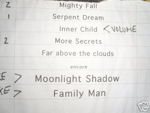 |
|
|
|
| Roland SH-101 |
Monophonic analogue synthesiser. |
|
|
|
| Roland JV-80 |
Digital synthesiser keyboard. |
|
|
|
| Roland GK-2A |
Guitar synth pickup |
|
|
|
| Roland RS-505 |
Analogue string synthesiser. |
|
|
|
| Studio Electronics SE-1 |
Analogue monophonic synthesiser |
|
|
|
| Roland Fantom XR |
Digital synth module, sold via Chandler Guitars in September 2008. |
|
2008/09 |
|
| Samplers |
| Fairlight CMI |
Mike claims to have been one of the first CMI owners. |
1979 |
|
|
| Fairlight CMI Series II |
Mike had two of these - the second was for live work. |
|
|
CrisesDiscoveryThe Killing Fields |
| Fairlight CMI Series III |
A further improvement of the CMI system, incorporating 16 bit sampling.

 |
|
|
IslandsEarth MovingHeaven's Open |
| Akai S-1100 |
Mike owned both an 8MB and a 32MB version. |
|
|
Heaven's OpenTubular Bells IIThe Songs of Distant Earth (Mike used two of these for playing back the many samples used on the album (as seen in the 1994 VH1 interview).) |
| Akai S-6000 |
Digital rackmount sampler. |
|
|
Tres Lunas [?]Tubular Bells 2003 (Used for playing back Mike's sample library.) |
| Digidesign SampleCell |
Mac-based sampling system. |
|
|
|
| E-Mu Emulator II |
Digital sampler keyboard with analogue filters. |
|
|
|
| E-Mu e64 |
Digital sampler. |
|
|
|
| Roland SP-700 |
Digital sample player. |
|
|
|
| Roland S-760 |
Digital sampler |
|
|
|
| Other keyboards |
| Parrot Piano Accordion |
Chinese-made 30 key, 32 bass piano accordion. |
|
|
OmmadawnTubular Bells 2003 |
| Wineha Spinet |
According to Les Penning, he and Mike travelled to Bradford in Mike's old Range Rover to buy this from Woods Early Music Shop. |
1975 |
1995 |
Ommadawn |
| IK Multimedia iRig Keys |
37 key mini keyboard controller |
2016 |
|
Return To Ommadawn |
| Mellotron |
Sold 16/10/1980 at Jackson's music auction at EMI's Abbey Road recording studios; Lot 59; $160 - $1000. Return To Ommadawn used a Mellotron software emulation. |
|
1980/10/16 |
Return To Ommadawn |
| Korg MicroKey USB |
|
|
|
|
| John Morley Clavichord |
|
|
1995 |
|
Percussion instruments |
| Glockenspiel |
Hired from Maurice Placquet for recording Tubular Bells. |
|
|
Tubular Bells |
| Triangle |
Hired for recording Tubular Bells, but seemingly not used on the album. |
|
|
Tubular Bells [?] |
| Tubular Bells |
Hired from Maurice Placquet for recording Tubular Bells. The usual story is that Mike saw them being taken out from a John Cale session and asked if he could keep them for his own session. In search of a better sound, Mike used a coal hammer and bent them. |
|
|
Tubular Bells |
| Bodhrán |
18" bodhrán decorated with a St John Eagle from the Book of Kells. The bodhrán (pronounced as bough-rahn or bow-rahn) is an Irish frame drum made from goatskin, played with a beater called a tipper or cípín. A bodhrán was also used on Return To Ommadawn in 2016. |
|
|
OmmadawnIncantationsFive Miles OutAmarokVoyager [?] (There is bodrhán on the album, but it's not clear whether this was played by Mike, one of the Irish musicians, or was just from a set of loops.)Return To Ommadawn |
| Paiste Symphonic Gong |
|
|
|
OmmadawnIncantations |
| Marimba |
|
|
|
OmmadawnIncantations |
| Premier Tubular Bells |
Brass tubular bells, as seen in the Boxed booklet photos. |
|
|
Ommadawn |
| Glockenspiel |
3 octave concert glockenspiel sold at piano auctions, December 2007. Not the one used on Tubular Bells and Hergest Ridge, but probably all albums after that. |
1975 |
2007/12 |
OmmadawnTubular Bells 2003 |
| Musser Vibraphone |
Shown in pictures of Mike with David Bedford at Througham in 1976. |
|
|
Incantations |
| Tubular Bells |
The 'toy' set bought for the making of Tubular Bells II. |
1991 |
|
Tubular Bells IITubular Bells 2003 |
| Cymbals |
|
|
|
Tubular Bells 2003 |
| Tambourine |
|
|
|
Tubular Bells 2003 |
| Triangle |
|
|
|
Tubular Bells 2003 |
| Tympani |
|
|
|
Tubular Bells 2003 |
| African Table Drums |
|
|
|
Return To Ommadawn |
| 2.5 octave glockenspiel in case |
Possibly a Yamaha YG-1210 |
|
|
Return To Ommadawn |
Drum machines and electronic percussion |
| Linn LM-1 |
Electronic drum machine, using samples of acoustic drums |
|
|
QE2 [?] (Can be seen in the 1981 Montreux concert video, but was released in 1980, so likely bought after the album was recorded.)Five Miles Out ('Linn Machine' is listed on the track sheet, and the LM-1 can be seen in the gatefold photo of his studio.) |
| Pollard Syndrum |
Possibly a syndrum quad. |
|
|
QE2 (Mentioned in the album credits.) |
| Roland CompuRhythm CR-78 |
Analogue drum machine |
|
|
QE2 |
| Simmons Claptrap |
Handclap synthesiser. |
|
|
QE2 (Mentioned in the album credits.) |
| Oberheim DMX |
Digital drum machine.

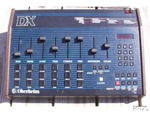 |
|
|
CrisesDiscovery (Can be seen on top of the OBXa in Mike's 'synth corner' shown on the sleeve of some LPs of the album.)The Killing Fields |
| Simmons Drums |
|
|
|
Crises |
| Boss Dr Rhythm |
Digital drum machine. |
|
|
Tubular Bells 2003 (Used for drums.) |
| Linn 9000 |
Drum machine and MIDI sequencer. |
|
|
|
| Roland PD-7 |
Drum pads. Sold via ebay in December 2007.
 
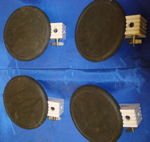 |
|
2007/12 |
|
| Roland SPD-11 |
Percussion pad and drum sound module. Sold via ebay in December 2007.

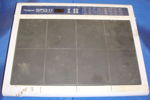 |
|
2007/12 |
|
Wind instruments |
| Penny Whistles |
By Generation and Waltons, in B♭, C, D, E♭, F and G. Used on Return To Ommadawn. |
2016 |
|
Return To Ommadawn |
Studio equipment |
| Headphones |
| Koss Pro 4AA headphones |
Mike can be seen wearing these in the making of Blue Peter feature, as well as pictures of him in Througham. |
|
|
Incantations |
| AKG K702-65 |
A special edition of the AKG K702 open backed headphones, produced to celebrate AKG's 65th anniversary. |
|
|
Return To Ommadawn (Shown prominently in the CD booklet.) |
| Beyerdynamic DT100 |
Mike sometimes wore these closed-back headphones on stage. He can also be seen wearing them in the All Right Now video clip, suggesting that he probably used them in the studio in the 80s. |
|
|
|
| Microphones |
| Neumann U87 |
Large diaphragm condenser microphone with selectable polar patterns. |
|
|
Ommadawn (This was, according to Les Penning, the microphone used on the recorders (and likely many other instruments) on Ommadawn.)Incantations (A pair of them can be seen above a marimba in a picture of Mike at Througham)Return To Ommadawn (Can be seen in Mike's photo collage on the album sleeve; it looks new, and a Neumann box can be seen in another photo.) |
| Neumann KM86 |
Used for recording acoustic guitars and many other instruments, from the Incantations era onwards. |
|
|
IncantationsQE2 [?] (The All Right Now clip suggests that Mike used these for for miking hi hats in this era. He probably continued to use them for acoustic guitars and other instruments as well.) |
| Shure SM57 |
Dynamic cardioid microphone. |
|
|
QE2 [?] (The All Right Now video clip suggests that Mike used these for snare drums around this time.)Tubular Bells 2003 (Used for vocals and guitar amps.) |
| Neumann TLM170 |
Multi-pattern large diaphragm microphone with transformerless output stage. |
1983 |
|
Crises (According to Simon Phillips in a 2016 video interview with Warren Huart of Produce Like A Pro, Mike was using the newly released TLM170 for acoustic guitars on Crises. ) |
| Bruel & Kjaer 4006 |
Small diaphragm omnidirectional condenser microphone.

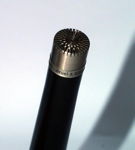 |
|
|
AmarokHeaven's OpenVoyagerTubular Bells 2003 |
| Bruel & Kjaer 4011 |
Small diaphragm cardioid condenser microphone. |
|
|
AmarokHeaven's OpenVoyagerTubular Bells 2003 (Used for piano, guitar amps, leslie speaker, glockenspiel, percussion and vocals.) |
| Bruel & Kjaer 4040 |
Large diaphragm omnidirectional condenser microphone. Serial Number 001. |
|
|
AmarokHeaven's OpenVoyagerTubular Bells 2003 (Used for classical guitar, flamenco guitar and steelstring acoustic guitar.) |
| AKG C12 |
Multi pattern large diaphragm valve condenser microphone. |
|
|
Tubular Bells 2003 (Used for piano.) |
| Beyerdynamic M160 |
Ribbon microphone. |
|
|
Tubular Bells 2003 (Used on piano.) |
| Neumann M249 |
Large diaphragm, multi pattern valve condenser microphone. A broadcast version of the M49, with 7 pin tuchel connector for superior rejection of RF interference. |
|
|
Tubular Bells 2003 |
| Neumann U67 |
Large diaphragm, multi-pattern valve condenser microphone. |
|
|
Tubular Bells 2003 |
| Apogee MiC USB microphone |
|
|
|
Return To Ommadawn (Shown in one picture in Mike's photo-collage on the album sleeve.) |
| Beyerdynamic M88 |
Dynamic microphone often used on Mike's tours in the 1980s, for acoustic guitars, vocals and guitar amps. |
|
|
|
| Loudspeakers |
| Tannoy Monitor Gold |
A pair of 15" Tannoy Monitor Golds were, according to Simon Heyworth, the main speakers in The Manor in the early 1970s. We have no information on what cabinets they were in. |
|
|
Tubular BellsHergest RidgeThe Orchestral Tubular Bells (Used when mixing the album at The Manor.) |
| Westlake TM-1 |
|
|
|
OmmadawnIncantations (Mike's studio at Througham had four of these, to allow him to mix in quad.)Platinum |
| Eastlake studio monitors |
After the problems with the Quad electrostatic speakers on the Exposed tour, Mike had a PA system built from Eastlake studio monitors. He would then use a pair, driven by one of the touring amp racks, in his temporary studios, as they were very similar to the Westlake monitors he was used to. |
|
|
QE2Discovery |
| Westlake HR-1 |
Studio monitor speaker. |
|
|
Five Miles OutCrisesIslands |
| Tannoy SRM10B |
10" Super Red Monitors. Used as nearfield monitors, as part of Mike's Islands-era video setup. Also used in Mike's Los Angeles studio while recording Tubular Bells II. |
|
|
IslandsTubular Bells II (Kept on a bookshelf at the back of Mike's Los Angeles studio, so probably not used for the bulk of editing and mixing work, but possibly used as a secondary (or tertiary) reference set.) |
| ATC SCM200 |
Studio monitor speakers.

 |
|
|
Earth Moving |
| Coastal Acoustics Boxer T4 |
|
|
|
Tubular Bells IIThe Songs of Distant EarthVoyagerTubular Bells IIIGuitarsThe Millennium BellTres LunasTubular Bells 2003 |
| Meyer HD-1 |
Nearfield monitors. |
|
|
Tubular Bells II (These appear to have been Mike's main nearfield speakers.)The Songs of Distant EarthVoyagerTres Lunas |
| Yamaha NS10 |
Nearfield monitors. |
|
|
The Songs of Distant Earth |
| Coastal Acoustics Boxer T2 |
Large studio monitoring speakers. |
|
|
Tres LunasTubular Bells 2003 |
| Dynaudio AIR 20 |
Three way active monitor with DSP. |
|
|
Light + Shade |
| Dynaudio AIR 25 |
|
|
|
Music of the Spheres |
| Genelec 8020B |
Mini powered monitor speakers. Mike used them in his editing setup in the conservatory of his house near Bristol. |
|
|
Music of the Spheres |
| Tannoy System 15 DMTII |
15" dual concentric studio monitors, used in Mike's main studio area in the Music of the Spheres era. |
|
|
Music of the Spheres |
| Yamaha HS80M |
8" active studio monitors. |
|
|
Music of the SpheresTubular Beats [?]Man on the RocksReturn To Ommadawn |
| Quested V3110 |
Active monitor speaker. Used in Mike's poolside studio in the Bahamas. |
|
|
Tubular Beats [?]Man on the Rocks |
| Quested X15 |
15" active subwoofer. Used together with the V3110s in Mike's Bahamas studio. |
|
|
Tubular Beats [?]Man on the Rocks |
| Bang & Olufsen BeoLab 4 computer speakers |
Small pyramid-shaped active speakers, which Mike keeps on top of his Yamaha HS50M monitoring speakers. The BeoLabs are presumably for checking what his mixes are like on consumer-grade equipment. |
|
|
Man on the RocksReturn To Ommadawn |
| Yamaha HS50M |
5" active studio monitors. Used in the smaller recording setup in Mike's Bahamas home. |
|
|
Man on the RocksReturn To Ommadawn |
| Studio effects and outboard |
| Urei 1176 Peak Limiter |
Mike originally borrowed some of these from the Manor Mobile, but later acquired his own. |
|
|
OmmadawnIncantationsPlatinum (These were still in Mike's rack in 1980 (shown in the Essential Mike Oldfield video) and so presumably still in use.)Tubular Bells II (Can be spotted in pictures of Mike's equipment rack in LA.)Tubular Bells 2003 |
| Allison Research Kepex |
Limiter, used in the 1970s (and possibly beyond) as part of Mike's guitar recording chain. |
|
|
Incantations |
| EMT 250 |
Digital reverb. |
1976 |
|
Incantations (Speaking to Guitar Player magazine in 1978, Mike said he also had a quadraphonic plate reverb, but liked the EMT250 better.) |
| ADR Vocal Stresser F769X-R |
|
|
|
Five Miles OutDiscovery (Used on Mike's distorted lead guitar parts.) |
| Klark Teknik DN70 digital time processor |
Digital delay unit. |
|
|
Five Miles Out (Can be spotted just behind the model plane on the LP gatefold picture, as well as in pictures of Mike's touring rig at the time.) |
| Quantec Room Simulator |
Digital reverb unit, released in 1982.

 |
|
|
CrisesAmarok |
| Urei 1178 dual channel peak limiter |
|
|
|
Crises (Mentioned by Simon Phillips in the Produce Like A Pro interview.)Tubular Bells IITubular Bells 2003 |
| Dolby SR Noise Reduction units |
Dolby SR was Dolby's most advanced form of tape noise reduction. SR stands for Spectral Recording, a reference to the way that the system can act independently on different parts of the frequency spectrum. |
|
|
IslandsEarth Moving |
| AMS Digital Delay |

 |
|
|
Amarok |
| Brooke Siren DPR502 MIDI controlled noise gate |
|
|
|
Amarok |
| Neve 1073 Mic Preamps |
Used on Amarok |
|
|
AmarokTubular Bells 2003 (Mike used 5 of these.) |
| Yamaha REV-7 |
Reverb unit.

 |
|
|
Amarok |
| Manor Module (mic preamp, EQ, compressor) |
Taken from the original Walsall Timing Developments mixer which was used to record Tubular Bells. Used for Mike's distinctive clean guitar sound. |
|
|
The Songs of Distant EarthTubular Bells 2003 |
| Eventide DSP-4000 |
High end digital effects unit, part of Eventide's successful Harmonizer series. |
|
|
The Songs of Distant EarthTubular Bells 2003 |
| Lexicon 480L |
|
|
|
The Songs of Distant Earth [?] (Mike mentions a Lexion reverb in the 1995 Sound on Sound interview and is probably referring to this one.) |
| TC Electronic M-5000 |
|
|
|
The Songs of Distant EarthTubular Bells 2003 |
| Belcaman C-102 |
Valve limiter. |
|
|
Tubular Bells 2003 |
| BSS DI Box |
|
|
|
Tubular Bells 2003 (Used for the Telecaster.) |
| Digidesign Pro Tools Mix Plus card |
DSP card for Digidesign Pro Tools. |
|
|
Tubular Bells 2003 (Mike had two of these installed in his Power Mac G4 for Tubular Bells 2003.) |
| Lexicon 300 |
|
|
|
Tubular Bells 2003 (Used for delays) |
| MOTU 828 Firewire |
|
|
|
Tubular Bells 2003 (Used with ASIO drivers for virtual synths and VST plugins.) |
| Yamaha SPX-1000 |
Multieffects processor. |
|
|
Tubular Bells 2003 |
| Digidesign 888/24 |
8 channel 24 bit I/O unit for Digidesign Pro Tools. Sold via Chandler Guitars in September 2008.

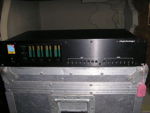 |
|
2008/09 |
Tubular Bells 2003 (Mike used four of these for Tubular Bells 2003) |
| Neve 8801 channel strip |
Mike owns eight of these mic preamp/EQ/dynamics units with built in AD/DA conversion, which he uses as a front end to his digital recording setup in the Bahamas. |
2010 |
|
Man on the Rocks |
| Avalon VT737sp |
Valve-based channel strip with preamp, compressor and EQ. |
2017 |
|
|
| Lindsay Audio Spectrum Analyser |
This was a 1/3 octave spectrum analyser, built by Paul Lindsay, who Mike had employed as a technical engineer and who had a workshop at Througham where he was manufacturing audio equipment for sale. The analyser was used by Mike in Througham, and can be seen in the Blue Peter feature. |
|
|
|
| Bel Flanger |
Probably a BF-20 |
|
|
|
| Eventide H-3000 Ultra Harmonizer |
|
|
|
|
| Jeanius Electronics Russian Dragon |
Audio timing analysis tool. |
|
|
|
| Korg SDD3000 |
Digital delay unit |
|
|
|
| BGW Systems 750 |
Power amplifier. Sold via eBay in December 2007.
 
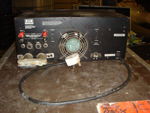 |
|
2007/12 |
|
| Mackie XLR10 |
Mic preamp expansion pod for the CR-1604. Runs off the CR-1604's internal power supply - did Mike own one, or was it modified?
Sold via eBay in December 2007. |
|
2007/12 |
|
| Digidesign Pro Tools Slave Driver |
Sold via Chandler Guitars in September 2008.

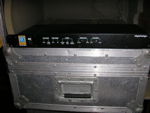 |
|
2008/09 |
|
| Tape recorders |
| Ampex MM1000 |
Multitrack tape recorder. A 16 track model was used for Tubular Bells and Hergest Ridge, while a 24 track from the Manor Mobile was used for Ommadawn. |
|
|
Tubular BellsThe Orchestral Tubular Bells [?] (The Manor Mobile's 24 track would most likely have been used for recording this album.)Ommadawn |
| TEAC A3300 |
1/4" stereo tape recorder. For much of the 1970s, its input stage was used as part of the signal chain for Mike's distorted guitar sound. |
|
|
OmmadawnIncantations |
| Ampex AG440C |
Used as a stereo mixdown machine in the Beacon. |
|
|
Ommadawn |
| Ampex MM1200 |
24 track, 2" multitrack tape recorder. As seen in the making of Blue Peter feature. |
|
|
IncantationsPlatinum |
| Ampex ATR-124 |
2" 24 track multitrack tape recorder.

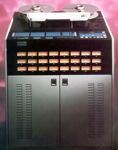 |
|
|
Five Miles OutCrises |
| Ampex Grand Master |
Recording tape. |
|
|
Five Miles OutEarth Moving |
| Studer A-800 |
2" 24 track multitrack tape recorder.
 
 |
|
|
Discovery (The remote unit for this machine can be seen in the 'Studio Switzerland' picture on the sleeve of some LP editions of the album.)IslandsEarth Moving |
| Sony PCM-3348 |
48 track digital multitrack tape recorder, recording to Ampex 467 1/2" oxide tape.

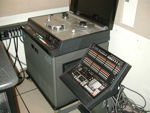 |
|
|
AmarokHeaven's OpenTubular Bells IIThe Songs of Distant EarthVoyagerTubular Bells III |
| TEAC 2340 |
1/4" reel to reel 4 track recorder, used in the early 70s for recording demos. It can be seen in some pictures of Mike at the Beacon. He gave it away around the time he moved to Througham. |
|
|
|
| Walkman with powered speakers |
Used as part of Mike's 1980s portable recording setup. |
|
|
|
| Nagra/Ampex VPR-5 |
Portable tape recorder

 |
|
|
|
| Bang & Olufsen Beocord |
1/4" reel to reel tape recorder, originally borrowed from Kevin Ayers to record the Tubular Bells demo tapes. |
|
|
|
| Mixing desks |
| Walsall Timing Developments 20 channel mixer |
Solid state analogue mixer, with 20 input channels, 16 mix busses and 4 stereo compressor/limiters. |
|
|
Tubular BellsHergest RidgeThe Orchestral Tubular Bells (Used when mixing the album at The Manor.) |
| Neve Series 80 |
A customised Neve Series 80, built for the Manor Mobile, but lent to Mike to use at The Beacon. The exact model it was based on is unknown. |
|
|
The Orchestral Tubular Bells [?] (Used for the recording at Barking Town Hall.)Ommadawn |
| Helios 10 Channel Sidecar |
10 channel mixer, built by Helios for the Manor Mobile, but installed into the Beacon for the recording of Ommadawn. From the All You Need Is Love documentary, it seems that Mike used its preamps and EQs to help achieve his guitar (and no doubt other) sounds before recording to tape. |
|
|
Ommadawn |
| Rebis Mixer |
According to Mike in Changeling, this was the first mixer built by Rebis, custom ordered by him for his Througham studio. It was designed as a quadraphonic desk, with quad panpots. After Mike had stopped using it in the studio, he had it put into flight cases and used it on his tours, as well as in many of his temporary studios. |
|
|
IncantationsQE2 (Used because the main studio at Denham was still unfinished, so this was brought back out of his touring setup.)Discovery (According to Richard Barrie, this was used as the front end for tracking.) |
| Midas live sound desk |
32 channel desk, probably a Pro5 (according to Richard Barrie). It was used as the front of house desk for Mike's live shows, but was also pressed into service for creating monitor mixes in some of Mike's temporary studio setups. |
|
|
QE2Discovery (This was, according to Richard Barrie, used for providing a monitor mix.) |
| Neve 8108 with NECAM automation |
Analogue mixing desk with computer automation system. |
|
|
Five Miles OutCrises |
| Harrison Series X |
The world's first fully automated mixing desk. Where desks like Mike's Neve 8108 often had little more than automation/recall of channel levels and mutes, the Harrison was able to automate other parameters like panning and aux sends, making it far easier to recall a mix. It was released in 1985, and Mike claimed that his was the first in England.

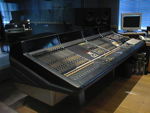 |
1986 |
1994 |
Islands (Mike told H & SR Magazine that this was the first Harrison in England, and that he and Simon Phillips used to play dice while waiting for the automation data to merge on its slow computer. Simon recalled in a 2016 interview for audio equipment company Elysia that the game they played was Kniffle (aka Yahtzee).)Earth MovingAmarokHeaven's OpenTubular Bells II |
| AMS Neve Capricorn 33238 |
Digital mixing desk. |
1993 |
|
The Songs of Distant EarthVoyagerTubular Bells IIIGuitarsThe Millennium BellTubular Bells 2003 |
| Yamaha 01V96 |
Mike said that he gave this to his 3-year-old son Jake to play with (!!). sold via Chandler Guitars in September 2008.

 |
|
2008/09 |
Light + Shade |
| Euphonix System 5-MC |
DAW control surface. |
|
|
Music of the Spheres |
| Avid Artist Mix |
Control surface for digital audio workstations, used in both of Mike's Bahamas studios. |
|
|
Tubular Beats [?]Man on the Rocks |
| Mackie CR1202 |
Mini mixer. |
|
|
|
| Yamaha DMP-7 |
Digital rackmount mixer. Sold via ebay in December 2007. |
|
2007/12 |
|
| Computers |
| Atari STacy portable computer |
Used as part of Mike's late 80s portable sequencing setup, together with the walkman with powered speakers and two Roland MT32 sound modules. |
|
|
Earth MovingHeaven's OpenTubular Bells II |
| Apple Macintosh Quadra 850 |
Running EMagic Logic Audio and Digidesign Pro Tools, connected to a 'two page' (usually used to describe a 21" CRT) monitor. It had four sets of Pro Tools hardware, to allow it to handle 16 tracks of audio. As mentioned in Sound on Sound, February 1995. |
|
|
The Songs of Distant Earth |
| Apple PowerMac G4 1GHz mirrored drive door |
With 1.25GB RAM, running OS 9.2 With Emagic Logic Audio Platinum 5.3.0 and Digidesign Pro Tools 5.3.1 |
|
|
Tubular Bells 2003 |
| Apple Powerbook 5300 |
Used for recalls and general word processing |
|
|
Tubular Bells 2003 |
| Apple PowerMac G4 466MHz |
With 1GB RAM, running OS 9.1, Logic Audio Platinum 4.8.1 and Pro Tools |
|
|
Tubular Bells 2003 |
| PC running Windows XP Pro |
Light + Shade era |
|
|
Light + Shade |
| Apple PowerMac G5 |
|
|
|
Light + Shade |
| Apple Mac Pro |
|
|
|
|
| Apple Powerbook 170 |
|
|
|
|
| Apple Powerbook 180 |
|
|
|
|
| Apple Macintosh Quadra 650 |
8MHz, 160MB HD. Running Opcode Studio Vision. |
|
|
|
| Apple Macintosh Quadra 700 |
With two page colour monitor. Running Emagic Notator Logic. |
|
|
|
| Silicon Graphics Indigo2 Extreme |
$40,000, with 20" monitor, 200MHz R4400 CPU, 128MB RAM, 2.1GB hard disc. Running Softimage. |
|
|
|
| Sequencers |
| EMS Universal Sequencer |
Related to the sequencer from EMS's Synthi KS (available both on its own and as part of the Synthi AKS suitcase synthesiser/sequencer, as used by Pink Floyd and Jean Michel Jarre, amongst others). The Universal Sequencer had control voltage and gate outputs for controlling analogue synthesisers. Mike primarily used it together with his ARP 2600. According to EMS, very few of them were made. |
|
|
Incantations [?]Platinum [?]QE2 [?]Five Miles Out (Shown in the photo of Mike's studio on inside of the gatefold of the LP) |
| Oberheim DSX |
Sequencer. Used as an interface between Mike's analogue synths and the Fairlight CMI. |
|
|
CrisesDiscovery (Can just be made out next to the DMX in Mike's 'synth corner' shown on the sleeve of some LPs of the album.) |
| C-Lab Notator |
Sequencing software for the Atari ST |
|
|
Earth MovingHeaven's OpenTubular Bells II |
| Emagic Logic Platinum |
5.3.0 |
|
|
Tubular Bells 2003 (Mike started with version 4.8.1 and upgraded to 5.3.0 during the recording.) |
| Emagic Notator Logic |
Descendent of C-Lab Notator, predecessor of Logic. |
|
|
|
| Linn 9000 |
Drum machine and MIDI sequencer. |
|
|
|
| Opcode Studio Vision |
Running on the Quadra 650. Notes are garbled - is it version 3, 5 or 3.5? |
|
|
|
| Hard Disk Recorders |
| Steinberg Topaz |
Hard disk recording system |
|
|
Heaven's Open |
| Fairlight MFX2 |
Hard disk recording system based on the CMI Series III architecture. Bought from Hilton Sound in 1994. |
1994 |
|
|
| Fairlight Merlin |
Hard disk recorder. |
|
|
Tres LunasTubular Bells 2003 (Recording at 24 bit, 48KHz) |
| Digidesign Pro Tools |
|
|
|
Tubular Bells 2003 (Mike used version 5.3.1) |
| Emagic Logic Platinum |
5.3.0 |
|
|
Tubular Bells 2003 (Mike started with version 4.8.1 and upgraded to 5.3.0 during the recording.) |
| Akai DR1200 ADAM |
Digital multitrack recorder. Bought just after Mike recorded Earth Moving. He told Keyboards magazine how it was helpful in simplifying the process of bouncing down tracks, compared to doing it to DAT from a 24 track, which was his previous way of doing it. He also mentioned how it can be synchronised to the 24 track to give him 12 additional tracks, or work alongside sequenced parts on his Atari ST using MIDI sync. |
|
|
|
| Computer software |
| C-Lab Notator |
Sequencing software for the Atari ST |
|
|
Earth MovingHeaven's OpenTubular Bells II |
| Steinberg Topaz |
Hard disk recording system |
|
|
Heaven's Open |
| Native Instruments B4 |
Virtual Hammond B3 Organ |
|
|
Tres Lunas |
| Digidesign Pro Tools |
|
|
|
Tubular Bells 2003 (Mike used version 5.3.1) |
| Emagic ES1 |
|
|
|
Tubular Bells 2003 (Virtual bass) |
| Emagic EVP88 |
|
|
|
Tubular Bells 2003 (Virtual Wurlitzer electric piano) |
| Emagic EXS24 |
|
|
|
Tubular Bells 2003 (Used for strings, flutes and organs.) |
| Emagic Logic Platinum |
5.3.0 |
|
|
Tubular Bells 2003 (Mike started with version 4.8.1 and upgraded to 5.3.0 during the recording.) |
| Focusrite EQ and Compression plugins |
|
|
|
Tubular Bells 2003 |
| Line 6 Amp Farm |
TDM plugin for Pro Tools. |
|
|
Tubular Bells 2003 |
| Native Instruments Pro 53 |
Virtual Prophet V plugin, an update of the Pro52 |
|
|
Tubular Bells 2003 (Used for synth and organ sounds.) |
| Native Instruments Absynth 3, Altered States, Morphology, Reaktor, Sounds of Polynesia, Wired |
Virtual instruments |
|
|
Light + Shade |
| Logic 7 |
Music editing software |
|
|
Light + Shade |
| Glaresoft iDrum |
Virtual instrument |
|
|
Light + Shade |
| FL Studio |
Music editing software |
|
|
Light + Shade |
| LinPlug Albino 2 |
Virtual instrument |
|
|
Light + Shade |
| reFX Vanguard |
3 oscillator, 32 voice analogue modelling synth plugin. |
|
|
Light + Shade |
| Spectrasonics Atmosphere, Stylus RMX |
Virtual instruments |
|
|
Light + Shade |
| Steinberg Groove Agent, Hypersonic, Kantos, Slayer, XPhrase |
Virtual instruments |
|
|
Light + Shade |
| VirSy Cantor |
Virtual vocalist software which, unlike Vocaloid, uses pure synthesis (and not samples) to generate its voices. |
|
|
Light + Shade |
| Yamaha Vocaloid |
Virtual vocalist software, capable of 'singing' using sets of voice samples. |
|
|
Light + Shade |
| Digidesign SampleCell |
Mac-based sampling system. |
|
|
|
| Emagic Notator Logic |
Descendent of C-Lab Notator, predecessor of Logic. |
|
|
|
| Native Instruments Pro 52 |
Software simulation of a Sequential Circuits Prophet 5 |
|
|
|
| Opcode Studio Vision |
Running on the Quadra 650. Notes are garbled - is it version 3, 5 or 3.5? |
|
|
|
Video equipment |
| Cyclorama |
|
|
|
|
| Aurora Digital Videographics System |
Was this the Aurora/100? |
|
|
|
| Bosch image generator |
Was this a pattern/colour bar generator? |
|
|
|
| CMX 340X video editor |
|
|
|
|
| Fairlight CVI |
Fairlight's Computer Video Instrument video effects unit. |
|
|
|
| Grass Valley 250 |
Video switcher/vision mixing console.

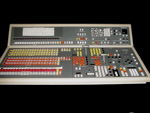 |
|
|
|
| Ikegami HL-79E broadcast camera |
Three tube portable broadcast camera.

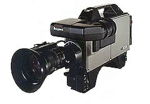 |
|
|
|
| Pro-Bel video patching |
|
|
|
|
| Quantel Mirage |
Video effects unit. |
|
|
|
| Sony BVH-2000 |
One inch type C VTR.

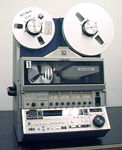 |
|
|
|
| Sony BVH-2500 |
One inch type C reel to reel VTR. Probably a BVH-2500P (the PAL version of the 2500).

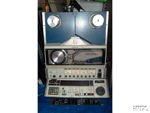 |
|
|
|
| Sony GC-2002 |
Rack for Sony BVH-2000 VTR. |
|
|
|
| Ultimatte Chroma Keyer |
|
|
|
|

